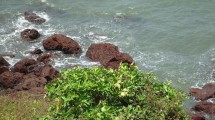Abstract
Two kinds ofCitrus (Rutaceae) known as “forbidden fruit” have been found growing in Saint Lucia, West Indies. These trees correspond closely with descriptions in the Caribbean literature of the early 19th century for kinds ofCitrus called “forbidden fruit.” The forbidden fruit was thought to be long extinct. The close relationship of the forbidden fruit to the grapefruit and the high degree of monoembryony observed among some of the selections may make them important genetic resources for sweet orange, grapefruit, and rootstock breeding programs.
Abstract
Deux sortes deCitrus (Rutacées) connues comme “fruit defendu” ont été trouvées se developper à Saint Lucia, Antilles (Indes de l’Ouest). Ces arbres correspondent de très près aux descriptions des genres de Citrus appelés ”fruit defendu“ trouvés dans la literature Caraïbe au debut du 1 9eme siècle. Il a été pensé que lefruit defendu a été eteint. La relation très proche entre le fruit defendu et le pamplemousse (pomelo) et le haut degré de monoembryonie observé entre quelques selections peuvent les metlre des ressources genetiques importantes pour les programmes de croisement et de propagation des oranges, de pamplemousses, et des porte-greffes.
Similar content being viewed by others
Literature Cited
Brickell, C. D., E. G. Voss, A. F. Kelly, and F. Schneider, ed. 1980. International code of nomenclature for cultivated plants-1980. Bohn, Scheltema & Holkema, Utrecht, Netherlands.
Britton, N. L. 1918. Flora of Bermuda. Charles Scribner’s Sons, New York.
Browne, P. 1756. The civil and natural history of Jamaica. Osborne and Shipton, London.
— 1789. The civil and natural history of Jamaica. 2nd ed. White and Son, London.
Fawcett, W., and A. B. Rendle. 1920. Flora of Jamaica. Vol. IV: dicotyledons. British Museum, London.
Freeman, W. G., and R. O. Williams. 1927. The useful and ornamental plants of Trinidad and Tobago. Government Printing Office, Port-of-Spain, Trinidad.
Hodgson, R. W. 1967. Horticultural varieties of citrus. Pages 431–591in W. Reuther, H. J. Webber, and L. D. Batchelor, ed., The citrus industry. Revised ed. Vol. 1. University of California Press, Berkeley.
Hughes, G. 1750. The natural history of Barbados. Book V. Printed for the author, London. (Reprinted in 1972 by Arno Press, New York.)
Hume, H. H. 1926. The cultivation of citrus fruits. Macmillan, New York.
Kumamoto, J., R. W. Scora, H. W. Lawton, and W. A. Clerx. 1987. Mystery of the forbidden fruit: historical epilogue on the origin of the grapefruit,Citrus paradisi (Rutaceae). Econ. Bot. 41:97–107.
Lunan, J. 1814. Hortus Jamaicensis 2:171–173. St. Jago de la Vega Gazette, Spanish Town, Jamaica.
Macfadyen, J. 1830. Some remarks on the species of the genusCitrus which are cultivated in Jamaica. Bot. Mise. 1:295–304.
— 1837. The flora of Jamaica; a description of the plants of that island. Longman, Orme, Brown, Green, and Longmans, London.
Maycock, J. D. 1830. Flora Barbadensis: a catalogue of plants, indigenous, naturalized, and cultivated in Barbados. James Ridgway, London.
Scora, R. W., and J. Kumamoto. 1983. Chemotaxonomy of the genusCitrus. Chapter 13in P. G. Waterman and M. F. Grundon, ed., Chemistry and chemical taxonomy of the Rutales. Academic Press, London.
—, —, R. K. Soost, and E. M. Nauer. 1982. Contribution to the origin of the grapefruit,Citrus paradisi (Rutaceae). Syst. Bot. 7:170–177.
Sloane, H. 1696. Catalogus plantarum quae in insula Jamaica sponte proveniunt. Brown, London.
Stafleu, F. A., V. Demoulin, W. Greuter, P. Hiepko, I. A. Linczevski, R. McVaugh, R. D. Meikle, R. C. Rollins, R. Ross, J. M. Schopf, and E. G. Voss. 1978. International code of botanical nomenclature. Bohn, Scheltema & Holkema, Utrecht, Netherlands.
Stehle, H., M. Stehle, and L. Quentin. 1937. Flore de la Guadeloupe et dependances. Tome II: catalogue des phanerogames et fougeres. Imprimerie Catholique, Basse-Terre, Guadeloupe.
Swingle, W. T. 1943. The botany of citrus and its wild relatives of the orange subfamily. Pages 129–474in H. J. Webber and L. D. Batchelor, ed., The citrus industry. Vol. 1. University of California Press, Berkeley.
Tussac, L. C. F. R. de. 1824. Flore des Antilles 3:73–74. L’auteur, Paris.
Webber, H. J. 1943. Cultivated varieties of citrus. Pages 475–668in H. J. Webber and L. D. Batchelor, ed., The citrus industry. Vol. 1. University of California Press, Berkeley.
Author information
Authors and Affiliations
Rights and permissions
About this article
Cite this article
Bowman, K.D., Gmitter, F.G. Forbidden fruit (Citrus sp., Rutaceae) rediscovered in Saint Lucia. Econ Bot 44, 165–173 (1990). https://doi.org/10.1007/BF02860484
Received:
Accepted:
Issue Date:
DOI: https://doi.org/10.1007/BF02860484




